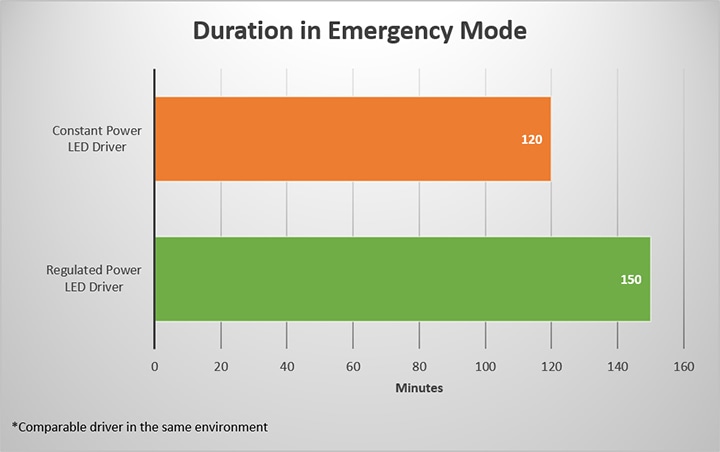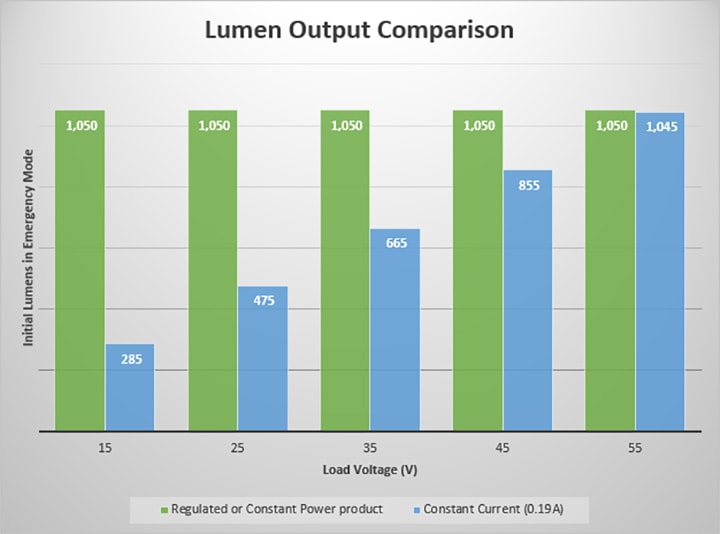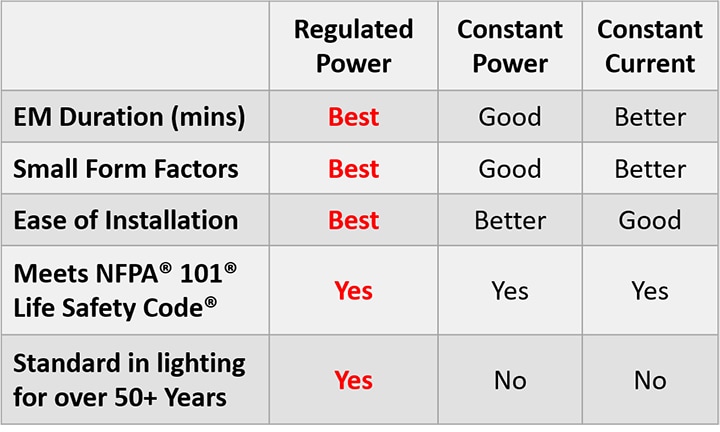
There’s been a lot of confusion and misinformation disseminated regarding LED emergency lighting power loads. In today’s LED emergency lighting industry, there are three prevalent types of load profiles and here we will explain each one. It’s important to note that all three meet NFPA® 101® Life Safety Code® (90-minute light output level ≥ 60% of the initial light output level) which is key to making sure your facility meets emergency lighting requirements.
Constant Power
Constant power provides a “constant” wattage to LED fixtures, giving a constant lumen output during the entire runtime that the fixture is in emergency mode. Since the power is constant, the level of current changes as the load LED voltage differs from one product to another according to current = power/voltage.

This approach of constant power will exceed the requirements for NFPA® 101® Life Safety Code®, which allows for a 40% drop in light output (so 40% drop in power) over the required 90-minute run time. In most situations, the battery will need to be larger to meet the extra power demand which could lead to potential form factor issues for installers as a larger battery will be needed, requiring a larger housing. Even though it meets the minimum time requirement to stay in emergency mode, other forms of technology, like regulated power, if in the same situation, have been shown to last longer while in emergency mode and still meet the NFPA® 101® Life Safety Code®. (Figure 1) The additional time provided with regulated power can allow individuals to navigate their way in an emergency and/or get out of a dangerous situation.
Regulated Power
Regulated power conserves energy by “regulating” the power which allows emergency lighting fixtures to last longer during an emergency while guaranteeing to meet NFPA® 101® Life Safety Code®. This enables smaller form factors and like constant power, does not require any additional configuration to guarantee the light fixture will meet NFPA® 101® Life Safety Code®. Regulated power may use a tapered light output, but the difference in lumen output is indiscernible to the naked eye.
Some of the benefits of regulated power are that it offers smaller form factors, reduces battery costs, and does not require any additional configuration, which help installers when in the field. Regulated power has been a standard in emergency lighting for over 50 years and is the standard for fluorescent, halogen and incandescent emergency lighting fixtures. Regulated power is patented by Bodine and found exclusively in Bodine LED emergency drivers; other companies utilize other less efficient methods to provide emergency power to emergency fixtures while maintaining code compliance.
Constant Current

Constant current, like constant power, provides a “constant” wattage, but only to a specific LED fixture design. However, unlike the regulated power and constant power emergency drivers, the output power of this approach changes as the LED voltage of the fixture design changes. (Figure 2) This creates more complexity in the selection and compatibility process when utilizing this type of emergency driver. The main reason is that the maximum allowable output power of the constant current emergency driver is determined by the maximum allowable LED load voltage. As the LED load voltage decreases, so does the output power. The result is that even though the efficacy of 2 luminaires with different LED load voltages may be the same, the one with the lower LED voltage will have lower output power and lower light output.
Synopsis

Regulated power, constant power and constant current will all meet NFPA® 101® Life Safety Code® requirements, but where they begin to differentiate themselves is the installation, implementation and use in emergency mode. When all things are considered, regulated power proves to be the best overall option. (Figure 3)
To learn more about regulated power or how regulated power can fulfill your LED emergency lighting needs, contact Bodine today at BodineTech@signify.com or (800) 223-5728. Bodine is the exclusive provider of regulated power LED emergency drivers in the industry and has been a leader in emergency lighting for over 50 years.

November 14, 2023
How lighting technology can help reduce risks to migrating birds